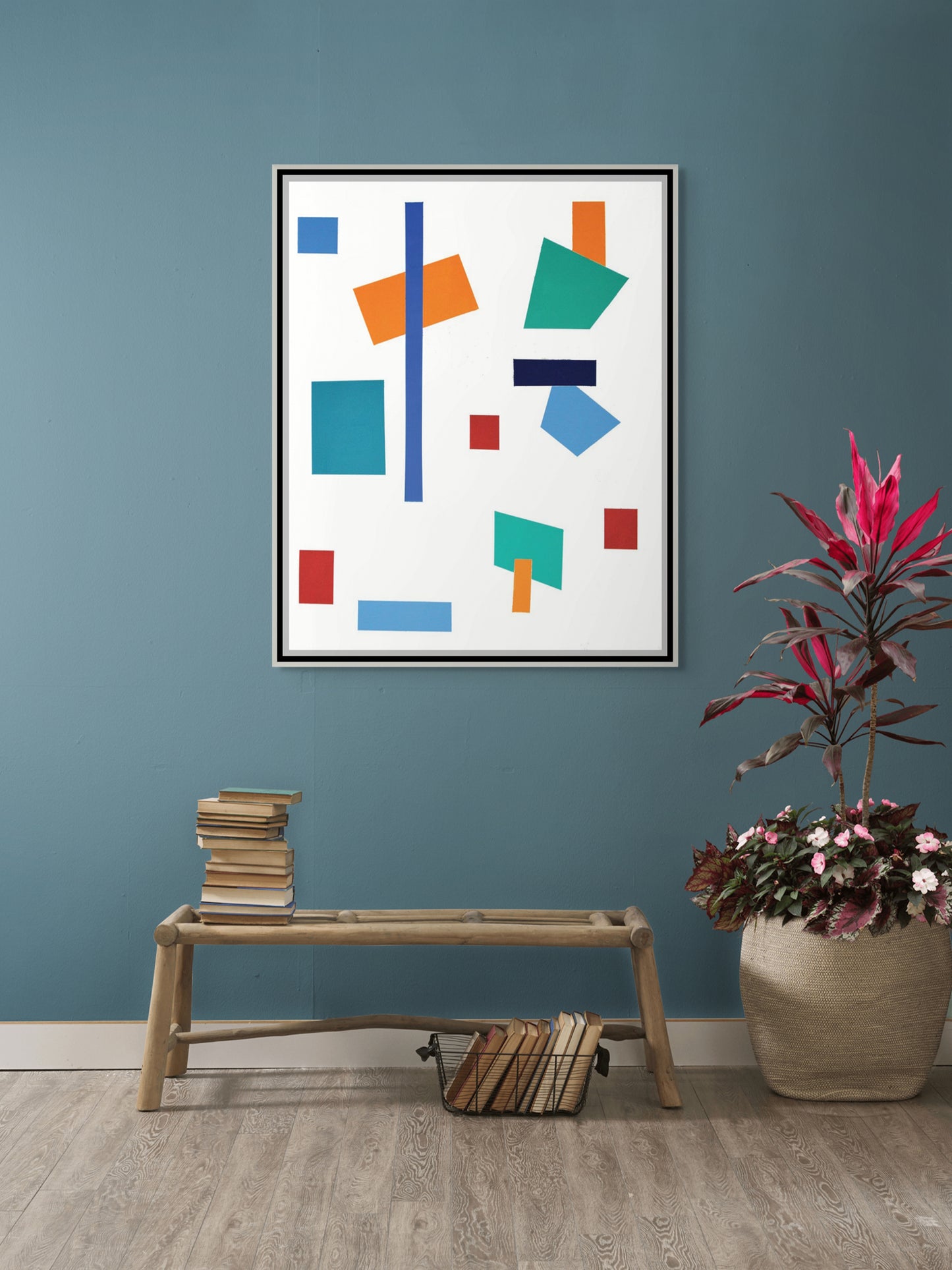Blue Line 36" x 48"
Blue Line 36" x 48"
See more paintings from the Floating Color Collection.

James Nowak’s Blue Line, from the Floating Color Collection, presents a striking exploration of geometry, abstraction, and spatial relationships. The work exemplifies the artist’s ongoing investigation into how color and form interact within a suspended, almost weightless environment. While the painting’s title emphasizes the central vertical blue bar, its deeper resonance lies in how this singular structural element redefines the balance, energy, and meaning of the entire composition.
The vertical blue line is the painting’s axis, running almost the full height of the canvas. It serves not merely as a compositional divider but as a gravitational force—an invisible spine around which the other shapes rotate, tilt, and settle. Its rigidity contrasts with the diagonally placed orange rectangle, the tilted green quadrilateral, and the irregular blue and teal forms that float across the white ground.
The painting rejects symmetry in favor of dynamic imbalance. Each shape appears to have been deliberately shifted off-center, creating visual friction. The large teal rectangle to the left and the more irregular shapes on the right engage in a silent negotiation of space, with the blue line holding the dialogue together.
The color palette is vivid, embracing Nowak’s characteristic commitment to bold primaries and strong complements. The blue line itself resonates with authority and calmness, while the fiery orange shapes inject energy, pushing against its stability. Red squares, strategically distributed, punctuate the composition like exclamation marks, interrupting the serenity of the white ground.
The juxtaposition of cool tones (blue, teal, aqua) with warm bursts (orange, red) echoes the rhythm of tension and release, balance and rupture. The white negative space amplifies this interaction, functioning not as absence but as an active field of suspension where forms can breathe and “float.”
As with other works in the Floating Color Collection, the central aesthetic of Blue Line lies in its evocation of buoyancy. The geometric shapes seem to hover without anchor, giving the impression of freefall or levitation. The blue line itself resists this weightlessness—it pierces the atmosphere like a pole planted in uncertain terrain. This tension between floating and grounding forces encapsulates the painting’s psychological depth: freedom exists only in relation to structure.
Emotionally, Blue Line oscillates between serenity and agitation. The vertical blue bar is stabilizing, almost meditative, while the tilted orange and green forms suggest disruption, movement, and unpredictability. The red squares add a sharper edge, preventing the composition from slipping into calmness.
This push and pull creates a resonance with lived experience: moments of order continually challenged by bursts of change. The painting thus embodies a metaphor for the balance between constancy and flux in human life.
Art historically, Blue Line recalls elements of Suprematism and Constructivism in its devotion to pure geometric form, but Nowak’s sensibility is less rigid than Malevich’s or Lissitzky’s. Instead of a utopian grid, his composition is playful, improvisational, and alive. The bold, flat planes of color also evoke Ellsworth Kelly’s chromatic clarity, yet Nowak diverges by layering his shapes into a field of implied motion.
The blue line can be interpreted as a stabilizer—perhaps symbolizing order, discipline, or a moment of stillness within chaos. Alternatively, it could represent division, marking boundaries across a field of free-floating possibilities. The painting’s openness to multiple readings is part of its strength: it is both formal abstraction and philosophical metaphor.
James Nowak’s Blue Line captures the essence of the Floating Color Collection through its interplay of color, geometry, and spatial energy. The commanding vertical blue line transforms a seemingly playful scattering of forms into a meditation on order and freedom. In balancing stability with levity, the work transcends simple geometry to embody the paradox of life itself: a constant negotiation between grounding forces and the desire to drift.

